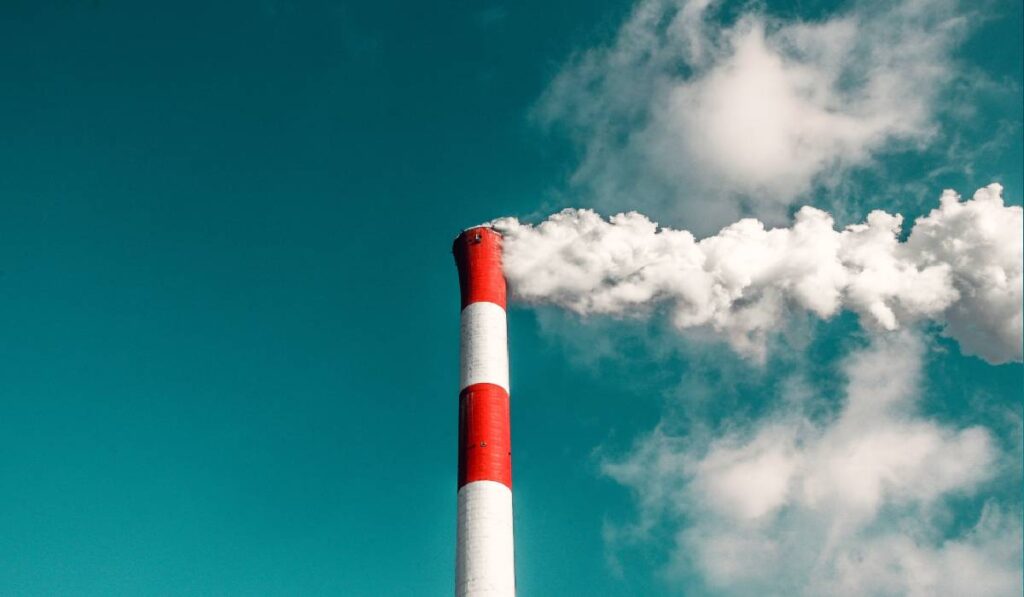How can an asthma inhaler have the same global warming impact as driving 175 miles? How can two cans of whipped cream be as harmful to the climate as heating your home for a whole day?
“Greenhouse gas emissions” and “carbon emissions” are terms that are often used interchangeably, but there is a difference. Carbon is just one of a variety of greenhouse gases (GHGs), all with different global warming potential.
The Paris Agreement recognises seven different types of greenhouse gas: our guide explains.
Carbon dioxide (CO2)
Carbon dioxide is the main greenhouse gas emitted by human activities. It is produced by burning fossil fuels such as coal, oil and natural gas. This means that activities such as power generation, driving petrol and diesel vehicles, aviation and industry all produce CO2. In 2020, it made up around 79% of anthropogenic emissions.
Because carbon dioxide is the most abundant greenhouse gas, it is used as the benchmark for stating the global warming potential (GWP) of all gases. GWP is expressed in terms of carbon dioxide equivalent, or CO2e. Because a tonne of carbon dioxide is obviously equivalent to a tonne of CO2e, we can state that the GWP of CO2 is 1. This means that it has the lowest global warming potential of all GHGs – but because we generate it in such great quantities, it is still by far the biggest contributor to human-caused global warming.
Methane (CH4)
Methane is produced by both geological and biological processes. Methane created through geological processes over millions of years is the main component of natural gas, a fossil fuel. Leaks from gas pipelines, such as the two Baltic Sea leaks in September 2022, send methane directly into the atmosphere.
Because methane tends to exist alongside other fossil fuels, methane leaks are also a key emissions source for the oil and gas industry.
The rest of the methane in the world is produced by biological processes. Some of these sources are natural, such as methane from the microbes that live in natural wetlands. But around 60% come from human activity, particularly farming. Rice paddies, digestive gas from livestock, landfills and sewage are all significant sources of methane emissions.
Most of it goes into the atmosphere, but it is possible to capture the methane from these processes for use. The main technologies are anaerobic digestion and gas recovery from landfill or wastewater treatment. The mix of gases from these processes is sometimes known as biogas, and when the pure methane is extracted it may be known as biomethane.
Methane has a GWP of 25, which means that a tonne of methane creates the same warming as 25 tonnes of carbon dioxide. It is much more effective than carbon at trapping heat in the atmosphere, but has a much shorter lifespan: around 12 years.
Nitrous oxide (N2O)
Nitrous oxide comes from both natural and human sources. It has always been part of the planet’s nitrogen cycle, produced by bacteria and fungi in the soil and oceans. In the late 18th century humans discovered how to produce it, and it has since been used for various purposes, including anaesthesia and as a rocket propellant.
Its propellant properties mean that nitrous oxide is frequently used in products that come in an aerosol container. But its GWP of 273 means that such products can have an outsize impact on the planet. It has been estimated that two cans of whipped cream have a carbon footprint of 8.7kg CO2e. The average UK household’s heating emissions in 2017 were 2745 kg CO2e; that’s just 7.52kg CO2e per day. So despite the miniscule quantities of nitrous oxide involved, those two cans of whipped cream generate emissions greater than a day’s heating.
Hydrofluorocarbons (HFCs)
Hydrofluorocarbons are a group of human-made compounds with a wide range of applications, including refrigeration, air-conditioning and fire extinguishing systems. They are also found in some asthma inhalers, which is why NICE is encouraging patients to choose greener inhalers where possible.
We do not yet have full knowledge of their global warming potential, but we do know that the GWP values of commonly used HFCs can be up to 12,500. The official values have changed over time in response to our growing knowledge about this class of GHGs.
Alongside their overall commitment to reduce GHG emissions generally, the European Union and the United States have also made a separate commitment to phase out HFCs. This is through signing a 2016 amendment to the 1985 Montreal Protocol, which was originally drawn up to protect the ozone layer.
Perfluorocarbons (PFCs)
Perfluorocarbons are a class of chemical compounds with carbon-fluorine bonds. The aluminium production industry is one of the biggest generators of this GHG. Other sources include refrigerants and solvents.
The simplest PFC, carbon tetrafluoride, has the lowest GWP of this group of chemicals: 7390. Perfluorocyclopropane has the highest GWP of 17340.
Sulfur hexafluoride (SF6)
Sulfur hexafluoride is mainly used in the electric power industry to insulate equipment such as circuit breakers and switches. When this equipment is decommissioned, it will be important to recover as much SF6 as possible to avoid it reaching the atmosphere. SF6 also has some medical uses and has been used in particle accelerators. It has a GWP of 22,800.
Nitrogen trifluoride (NF3)
Nitrogen trifluoride was not included in the original “basket” of GHGs recognised by the 1997 Kyoto Protocol, predecessor to the Paris Agreement. It was added in the second commitment period, taking the number of officially recognised GHGs from six to seven.
NF3 only existed in very small quantities before ways of synthesising it were invented in the 20th century. Its main use is in the manufacture of electronic goods such as display screens, solar panels and LEDs.
New measurement techniques have recently revealed that there is much more nitrogen trifluoride in the atmosphere than previously thought. This is alarming news because it is thought to have a GWP of 17,200.
Businesses reporting on their GHG emissions need to be aware of the seven GHGs. The importance of different GHGs to the climate impact of a business will depend on its sector and activities. It is crucial that businesses are clear on the different GWP of each gas and use the correct conversion factors in their calculations.

